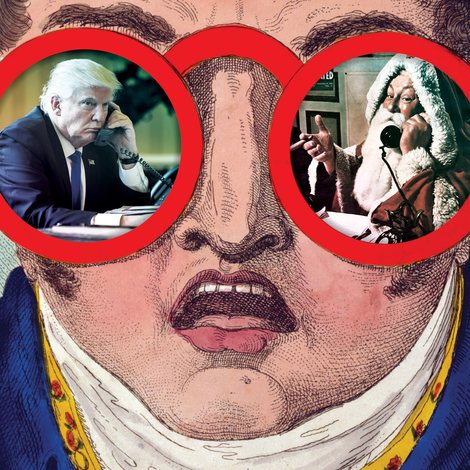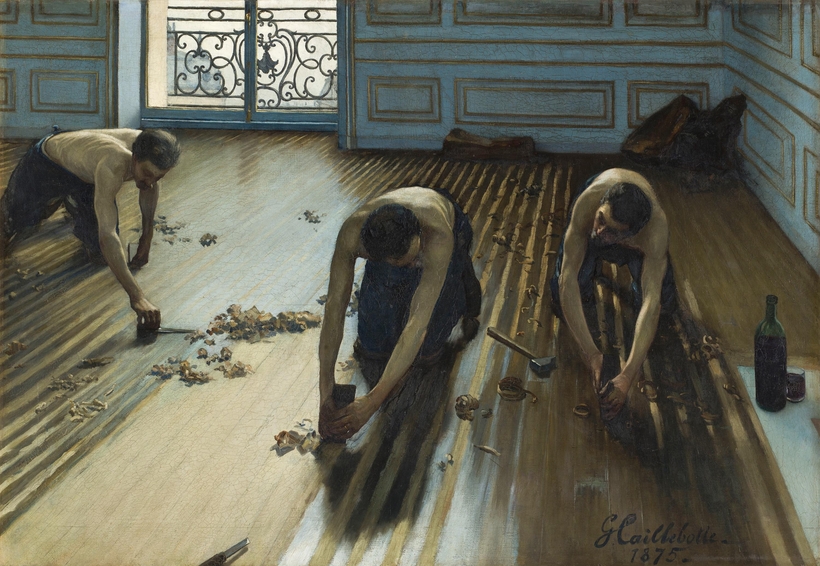In February 1876, Pierre-Auguste Renoir invited Gustave Caillebotte to take part in the second Impressionist exhibition—a follow-up to the group’s scandalous debut, in 1874, which had no jury and no prize, and threw open its arms to radical painters rejected by the state-sponsored Salon, artists such as Claude Monet and Paul Cézanne. Caillebotte, a 27-year-old former soldier and a qualified lawyer, had only been studying at Paris’s École des Beaux-Arts for three years. But his breakout work, The Floor Scrapers—daring in its perspective, vivid colors, and salacious subject of half-naked male laborers—was progressive enough to be denied by the Salon in 1875. The Salon’s loss was Impressionism’s gain.
What set Caillebotte apart from other painters of the time were his large-scale, incredibly realist pictures of the inhabitants of modern bourgeois Paris, which he rendered in brazenly unique compositions.
Thanks to an inherited fortune, he was also able to help bankroll fellow Impressionists, paying the rent for their studios and purchasing some 70 of their pictures before his death in 1894, at just 45. It is these relationships—with family, friends, and sitters—that are the focus of the exhibition “Gustav Caillebotte: Painting His World,” which opens tomorrow at the Art Institute of Chicago.

Fortunately, Caillebotte’s reputation has come a long way since he was billed as “The Unknown Impressionist” for a retrospective at London’s Royal Academy, in 1996. That show was based on the 1994–95 exhibition “Gustav Caillebotte: Urban Impressionist,” which was co-organized by the Art Institute of Chicago and its curator Gloria Groom. She recently said that it marked “the beginning of Caillebotte’s recognition as a really serious artist that needs to enter the canon.”

Fast-forward three decades. In 2023, the Musée d’Orsay, in Paris, spent $47 million on Caillebotte’s Boating Party, just two years after the Getty, in Los Angeles, bought Young Man at His Window for $53 million. When the curators at these museums asked Groom—the chair of painting and sculpture of Europe at the Art Institute of Chicago—to lend the museum’s Caillebotte masterpiece Paris Street; Rainy Day for a new show, she agreed on the condition that the show would come to Chicago as well.
The exhibition contains around 120 works, with more key loans that include Le Pont de l’Europe, from the Musée du Petit Palais, Geneva; Young Man Playing the Piano, from the Artizon Museum, Tokyo; and Nude on a Couch, from the Minneapolis Institute of Art. Coming from private collections are several important works, such as Luncheon; Balcony; Man Drying His Leg; and Interior, Woman at the Window.

When the exhibition was unveiled in Paris in October of last year, it was called “Gustav Caillebotte: Painting Men.” The focus was on Caillebotte’s relationships with more-often-than-not male sitters. Several prominent French newspapers complained that it had been influenced by “woke” American gender studies, even though the theme was conceived in Paris.

“We felt ‘Painting Men’ was too narrow and wanted to broaden the show,” Groom tells AIR MAIL. “He’s painting the world around him, and was deeply invested in his personal relationships, both familial and non-familial. And while these relationships include males he interacted with, we have centered the show on the artist’s full experience, the world he lived in, the distinct Paris he captured in his work.”
What does that mean in practical terms? Additional loans, a new chronological hang, different wall texts, and fresh picture labels.
“Gustave Caillebotte: Painting His World” will be on view at the Art Institute of Chicago from June 29 to October 5
Harry Seymour is a London-based art historian and writer


